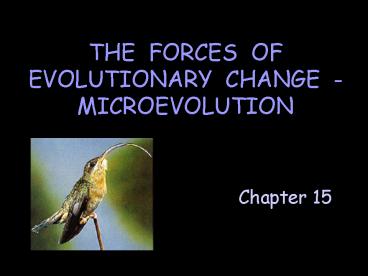THE FORCES OF EVOLUTIONARY CHANGE MICROEVOLUTION - PowerPoint PPT Presentation
1 / 20
Title:
THE FORCES OF EVOLUTIONARY CHANGE MICROEVOLUTION
Description:
Evolution occurs at the population level as allele frequencies ... Albinism among Arizona's Hopi Indians. 2. Migration. Individuals migrate between populations. ... – PowerPoint PPT presentation
Number of Views:219
Avg rating:3.0/5.0
Title: THE FORCES OF EVOLUTIONARY CHANGE MICROEVOLUTION
1
THE FORCES OF EVOLUTIONARY CHANGE -
MICROEVOLUTION
- Chapter 15
2
- Evolution occurs at the population level as
allele frequencies change.
3
- A. Hardy-Weinberg Equilibrium
- A theoretical state in which allele frequencies
of a population do not change from one generation
to the next. - H-W equilibrium is only possible if
- mating population is large
- mating is entirely random
- there is NO migration, mutation, or natural
selection
4
- Hardy-Weinberg Equation
- p2 2pq q2 1
- p2 frequency of homozygous dominant
individuals - 2pq frequency of heterozygotes
- q2 frequency of homozygous recessive
individuals - p frequency of dominant allele
- q frequency of recessive allele
- NOTE p q 1
5
- H-W example 1
- In a certain population, 36 have sickle cell
anemia. What is the frequency of the dominant
allele? - What do we know? (p2, 2pq, q2, p or q)
- q2 36 or 0.36
- What do we want to find?
p
Calculations ?q2 q ?0.36 0.6 q
0.6 p q 1 Thus, p 1 - 0.6 or 0.4
6
- H-W example 2
- In a certain population, the frequency of the
dominant allele is 0.7. What is the frequency of
heterozygous individuals? - What do we know? (p2, 2pq, q2, p or q)
- p 0.7
- What do we want to find?
2pq
Calculations p q 1 Thus, q 1 - 0.7
or 0.3 2pq 2 x 0.7 x 0.3 or 0.42
7
- From the previous example we know
- p 0.7 q 0.3 2pq 0.42
- Calculate the frequency of homozygous dominant
individuals.
0.49
Calculate the frequency of homozygous recessive
individuals.
0.09
- If there are 1000 individuals in this population,
how many are - heterozygous?
420
- homozygous dominant?
490
- homozygous recessive?
90
8
- H-W equilibrium provides a background against
which microevolution can be detected. - If allele genotype frequencies change from one
generation to the next, then evolution is
occurring with respect to that particular gene. - If frequencies remain unchanged, then evolution
is not occurring.
9
- B. Factors That Cause Microevolution in Natural
Populations - 1. Nonrandom Mating
- Nonrandom mating causes certain alleles to become
more common in future generations (some
individuals leave more offspring than others). - Ex. Albinism among Arizonas Hopi Indians
10
- 2. Migration
- Individuals migrate between populations.
- Immigrating individuals introduce new alleles.
- Emigrating individuals remove alleles.
- Ex. New York Citys waves of immigration
11
- 3. Genetic Drift
- A change in the gene pool of a small population
due to chance.
Genetic drift in human populations may be caused
by the founder effect or a population bottleneck.
12
- Founder effect genetic drift due to a few
individuals leaving a large population to found a
new group. - Unlikely that gene pool of founding population is
representative of original population. - Ex. Ellis-van Creveld syndrome among Pennsylvania
Almish.
13
- Population bottleneck genetic drift due to high
mortality in a population. - Unlikely that gene pool of the remaining
population is representative of original
population. - Ex. Pingelapese blindness among Pingelapese
people of the eastern Caroline islands. - Decreased genetic diversity among Cheetahs.
14
(No Transcript)
15
- 4. Mutation
- A change in the DNA - introduces new alleles
into the population.
Mutations can be beneficial, silent, or harmful.
16
- 5. Natural Selection
- The differential survival and reproduction of
organisms whose genetic traits better adapt them
to a particular environment. - Considered to be the major driving force of
evolution.
17
- Types of Natural Selection
- Directional Selection
- Environment selects against one phenotypic
extreme, allowing the other to become more
prevalent.
18
- Disruptive Selection
- Environment selects against intermediate
phenotype, allowing both extremes to become more
prevalent.
19
- Stabilizing Selection
- Environment selects against two extreme
phenotypes, allowing the intermediates to become
more prevalent.
20
- Balanced Polymorphism
- A form of stabilizing selection that maintains
deleterious recessive alleles in a population
because heterozygotes resist an infectious
disease. - Sickle cell anemia is maintained because
heterozygotes are resistant to malaria. - Cystic fibrosis is maintained because
heterozygotes are resistant to cholera typhoid
fever.































